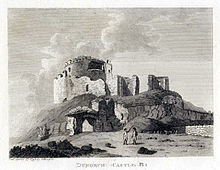Dundrum Castle (County Down)
Dundrum Castle ( Irish Caisleán Dhún Droma ) is a ruined castle above the village of Dundrum ( Dún Droma ) in County Down in Northern Ireland . John de Courcy had the castle built around the beginning of the 13th century after his conquest of Ulster . The castle, which was supposed to guard the access to the Lecale peninsula from the west and south, stands on a rocky hill, which offers a good overview of Dundrum Bay , the Morne Mountains , the land west to Slieve Croob and over the plains of Lecale to the east offers. The ruin is a State Care Historic Monument in Town Country of Dundrum in District Newry, Morne and Down .
history
13th Century
De Courcy's original castle may have had earth and wood defenses, but it is believed that the curtain wall of the upper courtyard was built in the early 13th century. As with other early enclosing walls, there were no towers here, but defense was facilitated by covered walkways along the top of the wall. An early knight's hall made of wood could have stood near the donjon , where there is a double toilet bay in the curtain.
In 1203 de Courcy was driven from Ulster by Hugh de Lacy . The first written mention of Dundrum Castle was in the Chronicles of Mann in the middle of the 13th century. It says that de Courcy besieged "Rath Castle" in 1205 without success with the help of 100 ships of his brother-in-law Rǫgnvaldr Guðrøðarson , King of the Islands .
In 1210 the castle was taken by King Johann Ohneland . Hugh de Lacy had the castle reinforced with a massive, round donjon, which he presumably commissioned master builders from the Welsh Marches , where such donjons were in fashion at the time. Even if a large part of the 2nd floor of this donjon was renovated in the 15th century, the draft of the old open fireplace and the spiral staircase leave no doubt that the donjon was originally at least three stories high. The ground floor served as storage and housed a cistern below the 1st floor, in which the daily used living room of the Lord was accommodated, while the 2nd floor was the private bedroom of the Lord. The castle remained in the possession of the crown until de Lacy was allowed to return to his earldom in 1226 . Presumably after the second award of the title Earl of Ulster (1227-1243), the gatehouse with two towers , similar to that of Pembroke Castle , was used in the curtain wall . It was built asymmetrically and had only one protruding tower that watched over the driveway along a narrow ramp from the southwest.
15th to 20th century
The stone curtain wall of the outer courtyard was probably built by the Magennis family from Morne, who took Dundrum Castle at the end of the 15th century. The Earl of Kildare briefly conquered the castle in 1517, as did Lord Deputy Gray in 1538. At that time, the castle was also called Magennis Castle . Phelim Magennis gave the castle to Lord Mountjoy in 1601 . In 1605 it was given to Lord Cromwell and sold to Sir Francis Blundell in 1636 . The Magennis family took the castle again in 1642, but later lost it again to the parliamentarians , who had it demolished in 1652 after they had withdrawn their garrison.
After 1660 the Blundells returned and had an L-shaped, gable-reinforced mansion built in the south-west corner of the outer courtyard. This house was in ruins when the property was passed to the second Marquess of Downshire in the early 19th century . The trees were probably planted at that time. In 1954 the remains of the castle and the property were transferred to the state by the 7th Marquess.
21st century
The castle is considered an important example of Norman architecture and is frequently visited by tourists and school children. Dundrum Castle was featured in an episode of the archaeological television program Time Team . It aired on Channel 4 on February 24, 2013 .
Gallery images
Individual evidence
- ^ Colm J. Donnelly: Living places: archeology, continuity, and change at historic monuments in Northern Ireland . Institute of Irish Studies, Queen's University of Belfast. 1997. Retrieved October 13, 2015.
- ↑ a b RA. McDonald: Manx kingship in its Irish sea setting, 1187-1229: king Rǫgnvaldr and the Crovan dynasty . P. 129.
- ↑ Dundrum Castle . In: Environment and Heritage Service NI - State Care Historic Monuments . Archived from the original on July 22, 2012. Info: The archive link was automatically inserted and not yet checked. Please check the original and archive link according to the instructions and then remove this notice. Retrieved October 13, 2015.
- ↑ a b c d e Dundrum Castle . Castles.nl. Retrieved October 13, 2015.
- ↑ Time Team: Series 20 - Episode 9: The lost castle of Dundrum . Channel 4. Retrieved October 13, 2015.
Web links
Coordinates: 54 ° 15 '23.8 " N , 5 ° 52' 26.4" W.






